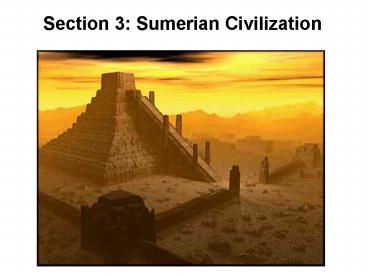Section 3: Sumerian Civilization - PowerPoint PPT Presentation
1 / 50
Title: Section 3: Sumerian Civilization
1
Section 3 Sumerian Civilization
2
The Story Continues Almost 4,000 years ago in
the town of Sumer, a father gave his son
theadvice that would be repeated by
fathersthroughout history Go to school, stand
beforeyour school-father, recite your
assignment . .After you have finished your
assignment . . .come to me. . . . Dont stand
about in the publicsquare, or wander about the
boulevard. Thestory of the Sumerians shows how
early peoplesof the Fertile Crescent passed
their cultures on tofuture generations.
3
I. The Fertile Crescent
- A strip of fertile land runs from the Isthmus of
Suez to the Persian Gulf
4
I. The Fertile Crescent
- The southeastern part was known as Mesopotamia
5
- A. Rivers
- The Tigris and Euphrates Rivers rise in Turkey
and flow through the Fertile Crescent
6
B. Flooding
- The Tigris and Euphrates flooded often and
deposited rich soil
7
B. Flooding
- Unlike the Nile, the floods were unpredictable in
size and timing
8
A. Rivers
- Farming began here Neolithic farmers settled in
the area called Sumer between 5000 and 4000 B.C.
9
- Sumer (or Shumer, Sumeria, Shinar, native
ki-en-gir) formed the southern part of
Mesopotamia from the time of settlement by the
Sumerians until the time of Babylonia. The
Sumerians called their country ken.gi(r)
'civilized land', their language eme.gir and
themselves 'the black-headed ones'
10
B. Flooding
- Farmers built canals and dikes to irrigate their
fields and return floodwater to the rivers
11
C. Invasions
- With little natural protection, wandering tribes
often invaded and conquered the valley
12
C. Invasions
- Around 4000 B.C. a people called Sumerians moved
into Mesopotamia
Ashurnasirpal II at War c. 875 BCE
Statues found at the Abu Temple in Tell Asmar
from c. 2700 BCE
13
II. Achievements
- A. Writing
14
A. Writing
- By 3000 B.C. Sumerians developed a form of
writing called pictographs
15
A. Writing
- They wrote by pressing marks into clay tablets
using a stylus
16
A. Writing
- Sumerian writing is called cuneiform, from the
Latin word for wedge, cuneus
17
A. Writing
- Sumerians had about 700 cuneiform signs
18
A. Writing
- Education was important - upper-class boys
learned to write, spell, draw, and do arithmetic
19
B. Architecture
- Sumerians probably invented the arch, a curved
structure that provides added strength
20
B. Architecture
- They built temples to their gods called
ziggurats, made of bricks placed in layers
21
C. Innovations
- The Sumerians are credited with inventing the
wheel
22
C. Innovations
- The Sumerians wrote arithmetic based on units of
60
23
C. Innovations
- They mapped the stars and divided a circle into
units of sixty
24
C. Innovations
- Sumerians created a lunar calendar that was kept
accurate by adding an extra month every 4 years
25
III. Society
- A. Government
- Sumerians developed a form of community called
the city-state
26
A. Government
- From early on, Sumer consisted of 12 city-states
Adab, Akshak, Bad-tibira Erech, Kish, Lagash,
Larak, Larsa, Nippur, Sippar, Umma and Ur. These
city-states were independent entities that often
waged war against each other
27
A. Government
- Some city-states had thousands of residents each
city-state had one or more gods
1. Himurta--Thunder Showers 2. Innanna--Morning
Star 3. Thunderbird 4. Ntu--Sun God. 5. Enki--God
of Sweet Waters..6. Isimud--Enki's Vizier
28
B. Social classes
- Kings, priests, and nobles were at the top of
society
29
B. Social classes
- Below them were by merchants and scholars
30
B. Social classes
- At the bottom were peasant farmers and slaves
31
C. Agriculture
- Sumerians grew dates, grains, and vegetables and
raised animals
32
C. Agriculture
- They grew flax for linen and wove wool for
clothing
33
C. Agriculture
- Surplus food was produced, allowing for job
specialization
34
C. Agriculture
- By 3000 B.C. Sumerians were trading by land and
by boat
35
D. Religion
- The Sumerians practiced polytheism and their gods
were linked to nature, the sun, and the moon
Anu the god of the highest heaven Marduk
national god of the Babylonians Tiamat dragon
goddess Kingu husband of Tiamat Enlil god of
weather and storms Nabu god of the scribal arts
Ishtar goddess of love Ea god of wisdom
Enurta god of war Anshar father of heaven
Shamash god of the sun and of justice Ashur
national god of the Assyrians Kishar father of
earth
36
D. Religion
- The Sumerians buried food and tools with their
dead
The 5,000-year-old Sumerian cemetery at Umm
al-Ajarib contains hundreds of thousands of
brick-lined graves in neat rows, with a variety
of burial goods.
37
D. Religion
- The dead went to a shadowy lower world, where
there was no reward or punishment
38
(No Transcript)
39
(No Transcript)
40
(No Transcript)
41
(No Transcript)
42
(No Transcript)
43
(No Transcript)
44
(No Transcript)
45
(No Transcript)
46
(No Transcript)
47
(No Transcript)
48
(No Transcript)
49
(No Transcript)
50
(No Transcript)

